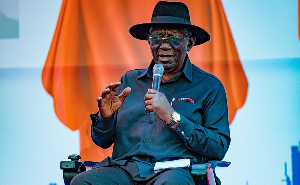By Kwame Apau
According to Nyanteng, Ghana experienced a rapid dietary shift to rice, particularly in the urban centres, during the early post-independence period (starting 1957). The trend was attributed to increased income, favourable government pricing policies, good storability of rice and ease of cooking.
Rice consumption in Ghana increased from 7.4 kg per caput/annum between 1982 and 1985 (WARDA, 1986) to 13.3 kg per caput/annum (Government of Ghana, 1996) resulting in a total annual consumption of 239 400 tonnes of milled rice (i.e. estimated on 18 million population). The annual consumption (1991-1996) thus showed an increase of 119 000 tonnes over that of 1990. The total paddy production was 329 080 tonnes, an estimate based on an average yield of 1.9 tonnes/ha over a total area of 173 200 ha.
In 2011, the District Chief Executive of South Tongu in the Volta Region, Mr Daniel Amelorku, at the a programme to release 1,000 hectares of land to Global Agri-Development Company (GADCO), said Ghana was poised to increase rice production from 20,000 metric tonnes to 200,000 metric tonnes by 2015 to become the highest producer in West Africa. He indicated that programme would be expanded to 4,000 hectares of land within four years to achieve the target.
In January 2015 the United States Department of Agriculture (USDA) projected that between October 2014 and September 2015, Ghana would import 600,000 metric tons of rice to augment the country’s needs To ensure the country does better, the Council for Scientific and Industrial Research (CSIR) introduced three varieties which were described as comparable in terms of quality with the imported ones.
These three, ‘Agra,’ ‘Togo Marshall’ and ‘Jasimai 85’. According to the Directorate of the Crop Services Division of the Ministry of Food and Agriculture (MoFA), in 2015 the country produced 400,000 metric tonnes of rice, which fell short of the local consumption by 300,000 metric tonnes. National rice consumption stands at 700,000 metric tonnes a year. At the same time 2014, the country spent $290 million importing 414,000 metric tonnes of rice to meet local consumption needs.
With all the efforts put together, we have lost track of one important thing. What happens to the rice we produce? A recent TV3 report indicated how farmers at the Asutsuare area have to grapple with how to sell their produce. According to the farmers, they are fortunate to have had rain throughout almost the whole year but after they have spent money and effort to produce the rice, they are left at the mercy of the weather. According to rice farmers, one needs between GH¢3,000 and GH¢5,000 to cultivate one hectare of rice.
Now when these farmers have sunk all that money into a project for which we have need of and then turn around to complain, then there is a HUGE DISCONNECT. First Disconnect A random investigation conducted indicated that many women would prefer Ghanaian rice to ‘perfumed’ imported rice. Their reasons are that: Most of the ‘perfumed’ can become watery and/or go bad when it is left over night Most of the ‘perfumed’ rice do not match what expect of a perfumed rice Most o the ‘perfumed’ rice do not cook well after all Most of the ‘perfumed’ rice are tasteless On the aspects of the Ghanaian grown rice the only challenge most women had was the length of time needed for cooking.
According to them cooking Ghanaian grown rice needed some time and patience or one may end up destroying the whole meal. Aside that Ghanaian grown rice is one of the best ever. Second Disconnect Amazingly you go around the all the market places around the country and especially where rice is sold and it will amaze you to realize that of all the various varieties of rice, Ghanaian grown rice is non-existent.
This DISCONNECT is amazing. These are a group of farmers lamenting that they hardly get the needed market for their products and her are people who wants to buy the same product lamenting how difficult it is to get the product which is getting rotten under some unfavourable condition Third Disconnect When our leaders call for producing in Ghana and using made in Ghana goods what exactly do they mean? We have a lot of institutions and programmes who purchase a lot of rice for food.
Talk about School Feeding Programme, Senior High institutions and many others. Why cant we make it a policy that such bodies use Ghanaian grown rice so that instead of paying some huge dollars to outside farmers we can use part of that to grow the Ghanaian farmer and create more employment? Until leadership and the populace stop paying lip service to issues to do with rice growing in particular and agriculture in general, we may have to contend with this use for a long time. We shall help create and help desecrate at the same time.
By Kwame Apau The Writer is a Communications Expert and a Lecturer. The Ag. Executive Director of PIPA
Opinions of Monday, 27 February 2017
Columnist: Kwame Apau
Ghana’s rice farming sector – the disconnect
Entertainment














